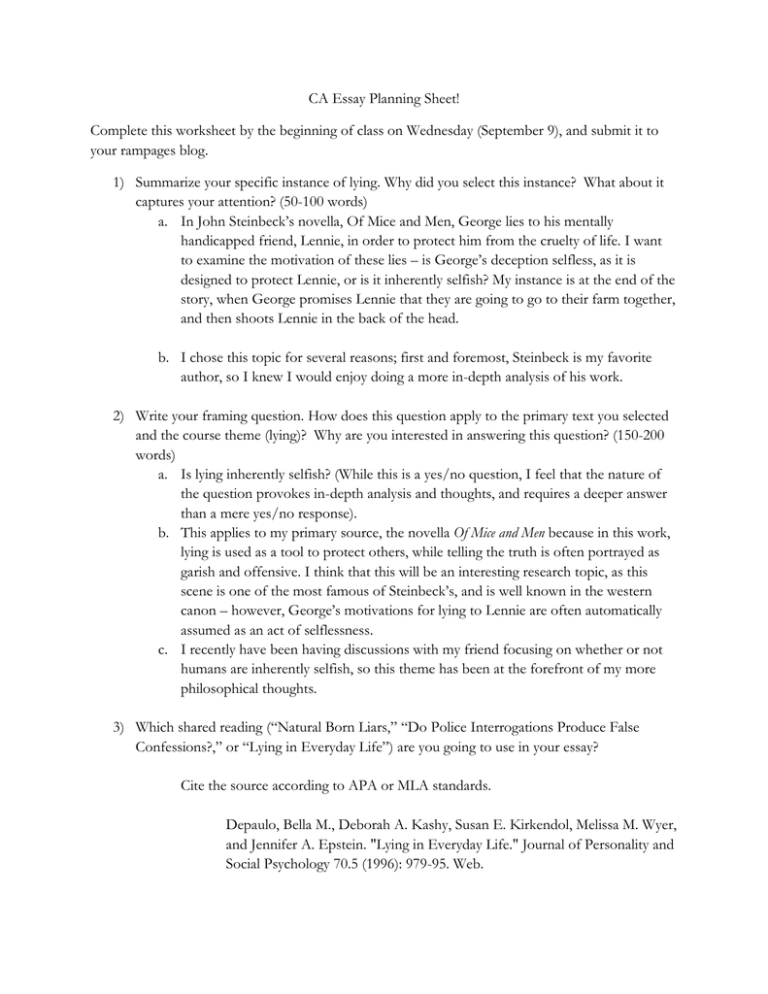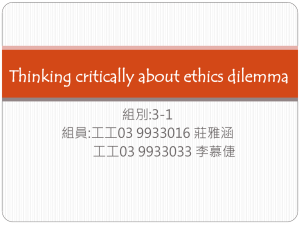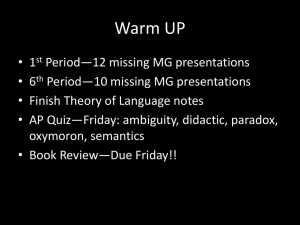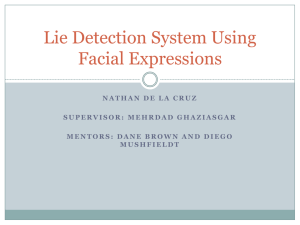Critical-Analysis-Essay-Planning-Worksheet1
advertisement

CA Essay Planning Sheet! Complete this worksheet by the beginning of class on Wednesday (September 9), and submit it to your rampages blog. 1) Summarize your specific instance of lying. Why did you select this instance? What about it captures your attention? (50-100 words) a. In John Steinbeck’s novella, Of Mice and Men, George lies to his mentally handicapped friend, Lennie, in order to protect him from the cruelty of life. I want to examine the motivation of these lies – is George’s deception selfless, as it is designed to protect Lennie, or is it inherently selfish? My instance is at the end of the story, when George promises Lennie that they are going to go to their farm together, and then shoots Lennie in the back of the head. b. I chose this topic for several reasons; first and foremost, Steinbeck is my favorite author, so I knew I would enjoy doing a more in-depth analysis of his work. 2) Write your framing question. How does this question apply to the primary text you selected and the course theme (lying)? Why are you interested in answering this question? (150-200 words) a. Is lying inherently selfish? (While this is a yes/no question, I feel that the nature of the question provokes in-depth analysis and thoughts, and requires a deeper answer than a mere yes/no response). b. This applies to my primary source, the novella Of Mice and Men because in this work, lying is used as a tool to protect others, while telling the truth is often portrayed as garish and offensive. I think that this will be an interesting research topic, as this scene is one of the most famous of Steinbeck’s, and is well known in the western canon – however, George’s motivations for lying to Lennie are often automatically assumed as an act of selflessness. c. I recently have been having discussions with my friend focusing on whether or not humans are inherently selfish, so this theme has been at the forefront of my more philosophical thoughts. 3) Which shared reading (“Natural Born Liars,” “Do Police Interrogations Produce False Confessions?,” or “Lying in Everyday Life”) are you going to use in your essay? Cite the source according to APA or MLA standards. Depaulo, Bella M., Deborah A. Kashy, Susan E. Kirkendol, Melissa M. Wyer, and Jennifer A. Epstein. "Lying in Everyday Life." Journal of Personality and Social Psychology 70.5 (1996): 979-95. Web. Write a summary of the text. Make sure that your summary states the main claim and the reasons given to support it. Refer to A Writer’s Reference for instructions on writing a good summary. (75-125 words) DePaulo, Kirkendol, Epstein, Kashy, and Wyer conducted a diary study of two different groups, college students and community members (adults) in order to gather information about lying. Questions they sought to answer included “How often do people lie? What do they lie about? Whom do they lie about? To whom do they tell their lies, and in what contexts? What reasons do they offer for telling their lies?” After collecting the worksheets, the researchers categorized their findings in both quantitative and qualitative forms in order to better understand the social function of lying. List keywords that capture why you think the source is important for your research. Lying, behavior, social interactions, reasons for lying, frequency of lying, perception of lying Identify at least two brief quotes from the reading. Thoroughly explain each quote, and then articulate why you think it will help you formulate a reasonable response to your question. Be as precise as possible. (275 words) “From these perspectives, the ‘self’ that is presented to others in everyday social life is characteristically an edited and packaged one. […] [T]he defining characteristic of deceptive presentations is that it is purposefully designed to foster a false impression.” (DePaulo 979) In this quote, the researchers are explaining the basis for the research; in previous studies, researchers determined that social interactions involved the tailoring of the self in order to foster a more desirable image, whether or not the interaction involved deception. I think this is pertinent to my research, as it shows that other’s perception of the presented ‘self’ is central in any interaction; it shows, to some degree, that every interaction involves selfishness, and therefore deception would be no different. “We, too, believe that lies are more often told to serve the self and others. However, we think that lies are told less often in the pursuit of goals such as financial gain ad material advantage and instead are much more often told in the pursuit of psychic rewards such as esteem, affection, and respect.” (DePaulo 980) The researchers claim that they believe lying is for selfish reasons, not for altruistic reasons – however, rather than be for monetary or physical gain, the intention of deception is to receive psychological recompenses. While lying may be used to in order to comfort others or to preserve their feelings, the underlying cause of this deception is inherently selfish, as the liar will receive positive feedback through approval or avoidance of confrontation. Copy and paste the claim of the piece from the source. Then state the claim in your own words. ‘If we are correct in assuming that lies are a fact of social life then we should find that they are only of minor cognitive or emotional significance to the people that tell them.” (980) The researchers’ claim is that deception is not only a consistent aspect of human social interaction, but is so common that people do not place major consequence on the lies that they tell – essentially that lying is so pervasive it is essentially morally permissible. 4) Substantive Source (provide link or .pdf) Cite the source according to APA or MLA standards. Martin, Clancy. "Good Lovers Lie." The New York Times. The New York Times, 07 Feb. 2015. Web. 08 Sept. 2015. Write a summary of the text. Make sure that your summary states the main claim and the reasons given to support it. Refer to A Writer’s Reference for instructions on writing a good summary. (75-125 words) Martin’s claim is that lying is not only pervasive in our society, but it is essential for the maintenance of positive relationships. He holds that lying is not only morally permissible, but it is expected between people in a personal relationship, especially an intimate one. These smaller surface lies are vital in maintaining a close bond, and while these surface lies may not be true in specific instances, they reveal “a deeper truth that is necessary for the love to be sustained.” List keywords that capture why you think the source is important for your research. Lying, relationships, love, caring, truth, fearing, betrayed, expectations Identify at least two brief quotes from the reading. Thoroughly explain each quote, and then articulate why you think it will help you formulate a reasonable response to your question. Be as precise as possible. (275 words) “What is true one hour can become a lie the next, and vice versa. Some days saying “I love you” doesn’t feel honest at all, but it expresses a deeper truth that is necessary for the love to be sustained.” (Martin) In this quote, Martin is trying to express that while lying in a particular moment may not express one’s present feelings, it can express more profound, long term-feelings. His theory is that little lies told in a relationship are used as band-aids during more difficult instances in order to preserve a meaningful commitment. Additionally, feelings shift and change during a relationship; smaller undulations of emotion can (and should) be lied about in order to better represent the underlying, truer emotions. This idea is pertinent to my research, as it is claiming that protecting someone else’s feelings is a valid, and sometimes necessary, cause to lie. While I believe that lying can be used to protect others, in doing so one is also guarding others’ perception of the self – an act that is more selfish than being forthcoming with the truth. “Love is a greater good than the truth. No marriage, no parent’s love of a child should be scrutinized like a pathologist examining his cadaver.” (Martin) This quote is fairly straightforward – love is more complex than things that can be broken down to chemicals and formulas, and in such a subjective area pure, brutal honesty is nothing short of “ruthless”. Copy and paste the claim of the piece from the source. Then state the claim in your own words. “Love is a greater good than the truth. No marriage, no parent’s love of a child should be scrutinized like a pathologist examining his cadaver. Save your ruthless pursuit of the truth for the laboratory […] Don’t worry so much about ferreting out the truth. Take care of each other instead.” In his article, Marin claims that preserving personal relationships is not only more important than honesty, but that relationships cannot be preserved without lying. Martin makes the case that lying is a selfless and expected act in order to maintain peace and love in any relationship. 5) Scholarly Source (provide pdf) Cite the source according to APA or MLA standards. Kaplar, M. E. and Gordon, A. K. (2004), The enigma of altruistic lying: Perspective differences in what motivates and justifies lie telling within romantic relationships. Personal Relationships, 11: 489–507. doi: 10.1111/j.1475-6811.2004.00094.x Write a summary of the text. Make sure that your summary states the main claim and the reasons given to support it. Refer to A Writer’s Reference for instructions on writing a good summary. (75-125 words) In this study, Kaplar and Gordon collected narratives of lying from undergraduate psychology students, male and female, and analyzed the author’s interpretations of the lies. Participants provided two written narratives, one an instance of lying to a romantic partner, and an instance in which they were lied to by a romantic partner. Kaplar and Gordon then evaluated the similarities and differences in the student’s narrative as a lieteller and a lie-receiver, and their interpretations of the lie-teller’s motives. List keywords that capture why you think the source is important for your research. Lying, deception, motivation for lying, altruistic lying, interpretations of lying Identify at least two brief quotes from the reading. Thoroughly explain each quote, and then articulate why you think it will help you formulate a reasonable response to your question. Be as precise as possible. (275 words) “We assumed that lies, like most behaviors, are multiply determined and stem from multiple motives, of which, as noted, an individual may or may not be aware.” (Kaplar 490) In this quote, the researchers explain that lying usually does not have one individual cause, but rather a multitude of causes, some of which the subject may not be cognizant of. This is relevant to my research as I am trying to analyze the cause of lying and determine whether it is selfish; while lying may have a multitude of causes, I believe that there is a root cause to all motivations to lie (the root cause being selfishness). “Our main hypothesis was that lie-teller narratives would contain more references to altruistic motivations on the part of the lie-teller than the lie-receiver narratives. Consistent with this prediction, more lie-teller than lie- receiver narratives contained references to lie tellers lying to avoid upsetting and hurting the lie receiver.” (Kaplar 496) Perspective is essential to the moral interpretation of a lie – however people tended to think of themselves as more noble and altruistic liars, while those that were lied to usually thought that the lie was cruel and selfish. This is relevant to my study as it implies that lies often hurt the ones the lies were meant to protect, and that ego plays a role in the interpretation of a lie. Copy and paste the claim of the piece from the source. Then state the claim in your own words. “We expected lie tellers to be more likely than lie receivers to construe their motivations altruistically and less likely to construe their motivations egotistically.” (Kaplar 493) In this study, Kaplar and Gordon claim that the motivation for lying is interpreted differently depending on the participant’s role in the lie, with liars seeing their lies as acts that are more selfless and kind, but when lied to they interpret the motivations as malevolent or selfish. 6) Synthesis Matrix Seeing how various sources fit together is challenging. The synthesis matrix is designed to establish how your sources converse with one another to help you have a robust understanding of how they weigh in on your question. You will design a matrix using the four sources (1 shared reading, 1 substantive source, 1 scholarly source, and 1 popular secondary source or primary text) you will use in your Critical Analysis Essay. This will illustrate the main ideas/topics of your sources in relation to your question: what they specifically assert regarding it. Fill out the template at the bottom of this assignment (page 2). Line up your four sources in the left hand column of the grid and then write your two or three categories across the top column. Your categories should be important aspects of the topic of your paper. Example: If I were writing about a particular song, I might generate the following categories as important aspects of why it is my favorite: tempo, lyrics, & syncopation. Note: The point here is to weave together the commonalities between your sources—what do all your sources say about each category. Be thorough with what each source has to say regarding the categories. You must write the information in the grid using complete thoughts/sentences. Use direct quotes from your sources, making sure to provide in-text citations. Additionally, you must provide nuanced and clear explanations of what each quote reveals about its category. Framing Question: Is Lying Inherently Selfish? Source 1 (Of Mice and Men, Steinbeck Source 2 “Lying in Everyday Life”, DePaulo Source 3 “Good Lovers Lie”, Martin Source 4 “The Enigma of Altruistic Lying”, Kaplar Category #1 Category #2 Category #3 Moral “interpretation” of lying Reasons for lying Nature of Relationship Lying = protection and defending the weak, truth = garish, offensive, “tmi” Protecting others (altruistic) Close friends Lying = common in everyday life, makes participants uncomfortable but not morally “bad” “Self-motivated” and “Other-Motivated” Varied Lying = essential to protect relationships, comes from a place of love Protect loved ones’ feelings Family and romantic partners Lying has different interpretations on whether you are the liar or recipient; liar perceives lies as altruistic while recipient perceives lies as unjust Different interpretations based on role in lie / varied, complex and sometimes simultaneously altruistic and selfish Romantic partners






